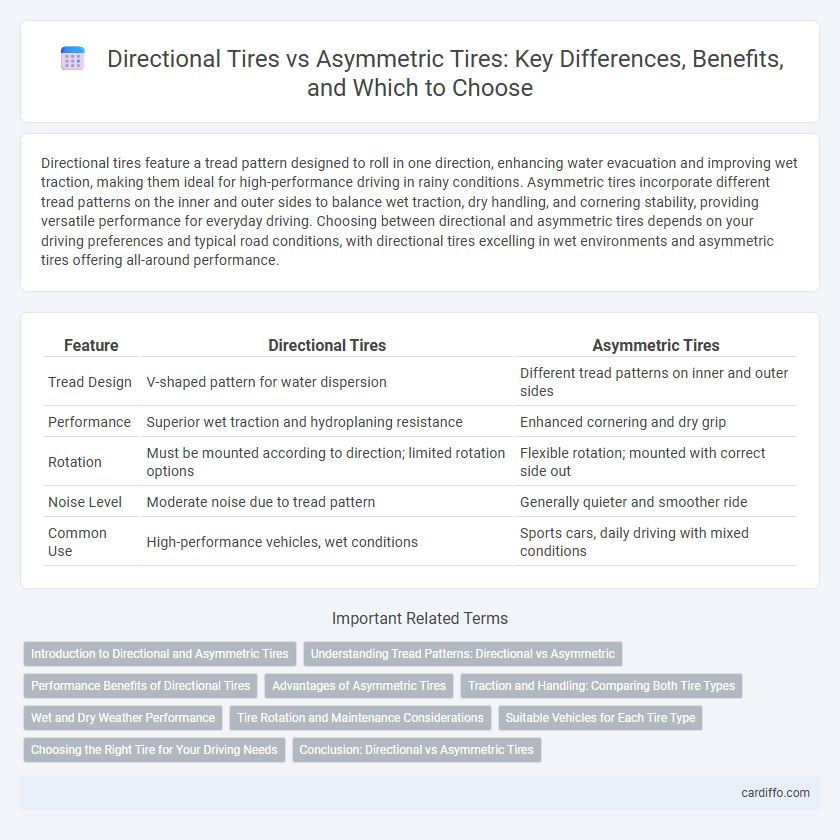Directional tires feature a tread pattern designed to roll in one direction, enhancing water evacuation and improving wet traction, making them ideal for high-performance driving in rainy conditions. Asymmetric tires incorporate different tread patterns on the inner and outer sides to balance wet traction, dry handling, and cornering stability, providing versatile performance for everyday driving. Choosing between directional and asymmetric tires depends on your driving preferences and typical road conditions, with directional tires excelling in wet environments and asymmetric tires offering all-around performance.
Table of Comparison
| Feature | Directional Tires | Asymmetric Tires |
|---|---|---|
| Tread Design | V-shaped pattern for water dispersion | Different tread patterns on inner and outer sides |
| Performance | Superior wet traction and hydroplaning resistance | Enhanced cornering and dry grip |
| Rotation | Must be mounted according to direction; limited rotation options | Flexible rotation; mounted with correct side out |
| Noise Level | Moderate noise due to tread pattern | Generally quieter and smoother ride |
| Common Use | High-performance vehicles, wet conditions | Sports cars, daily driving with mixed conditions |
Introduction to Directional and Asymmetric Tires
Directional tires feature a distinct tread pattern designed to rotate in one direction, enhancing water evacuation and improving wet traction for safer driving. Asymmetric tires combine different tread patterns on the inner and outer sides, optimizing grip, handling, and wear resistance by balancing performance and comfort. Both tire types cater to specific driving needs, with directional tires excelling in wet conditions and asymmetric tires offering versatile performance for everyday use.
Understanding Tread Patterns: Directional vs Asymmetric
Directional tires feature a V-shaped tread pattern designed to channel water away from the tire quickly, enhancing wet traction and reducing hydroplaning risk. Asymmetric tires combine different tread patterns on the inner and outer sections, optimizing wet grip on the inner side and dry handling on the outer side. Understanding these tread designs helps drivers select tires that match their driving conditions and performance needs.
Performance Benefits of Directional Tires
Directional tires provide superior water evacuation through their unidirectional tread pattern, significantly reducing hydroplaning risk and enhancing wet traction. Their design optimizes high-speed stability and cornering performance by offering increased lateral grip and precise steering response. This makes directional tires especially beneficial for sporty and performance vehicles that demand reliable handling in both dry and wet conditions.
Advantages of Asymmetric Tires
Asymmetric tires offer enhanced handling and cornering stability due to their distinct tread pattern designs on the inner and outer sides, optimizing traction in both wet and dry conditions. The outer side typically features larger tread blocks for improved grip during turns, while the inner side incorporates smaller grooves to efficiently channel water and reduce hydroplaning. These characteristics make asymmetric tires particularly advantageous for performance vehicles seeking balanced stability, safety, and all-weather reliability.
Traction and Handling: Comparing Both Tire Types
Directional tires feature a tread pattern designed to channel water away and enhance traction on wet surfaces, providing superior grip during straight-line acceleration and high-speed cornering. Asymmetric tires combine different tread patterns on the inner and outer sides to optimize dry handling and wet traction, offering better stability and precise steering response in varied driving conditions. Both tire types improve performance, but directional tires excel in wet traction while asymmetric tires deliver balanced handling for everyday and sporty driving.
Wet and Dry Weather Performance
Directional tires excel in wet weather performance by efficiently channeling water away from the tread, reducing hydroplaning risk and enhancing grip on wet surfaces. Asymmetric tires provide superior dry weather handling through their varied tread patterns, optimizing traction and cornering stability. Both tire types balance performance, but directional tires focus on water evacuation, while asymmetric tires emphasize versatile traction in dry conditions.
Tire Rotation and Maintenance Considerations
Directional tires require rotation only front-to-back on the same side to maintain their tread pattern integrity, while asymmetric tires allow more flexible rotation patterns, including side-to-side swaps, enhancing even tread wear. Proper rotation schedules, typically every 5,000 to 7,500 miles, are crucial for both types to maximize tire lifespan and maintain optimal traction. Monitoring tread depth and tire pressure regularly supports effective maintenance and ensures safety performance for directional and asymmetric tires.
Suitable Vehicles for Each Tire Type
Directional tires are ideal for sports cars and high-performance vehicles requiring enhanced traction and water dispersal at high speeds, making them suitable for aggressive driving conditions. Asymmetric tires are designed to provide a balanced combination of comfort, handling, and longevity, fitting well with sedans, SUVs, and touring vehicles that demand versatility in varied road conditions. Choosing the right tire type depends on the vehicle's purpose, driving style, and typical weather environments to maximize safety and performance.
Choosing the Right Tire for Your Driving Needs
Directional tires offer superior water evacuation and enhanced traction in wet conditions thanks to their V-shaped tread pattern, making them ideal for drivers frequently encountering rainy weather. Asymmetric tires combine varied tread patterns on the inner and outer sections to optimize cornering grip and straight-line stability, suitable for performance-oriented driving on dry and mixed road surfaces. Selecting the right tire depends on your typical driving environment, prioritizing directional tires for wet-weather performance and asymmetric tires for balanced handling and versatility.
Conclusion: Directional vs Asymmetric Tires
Directional tires excel in water evacuation and enhanced traction on wet surfaces due to their V-shaped tread pattern, making them ideal for performance driving in rainy conditions. Asymmetric tires feature distinct tread patterns on the inner and outer edges, optimizing cornering grip and stability while maintaining good wet and dry performance, suitable for everyday and sporty driving. Choosing between directional and asymmetric tires depends on driving conditions and performance priorities, with directional tires favored for wet traction and asymmetric tires preferred for balanced handling and versatility.
Directional tires vs asymmetric tires Infographic

 cardiffo.com
cardiffo.com